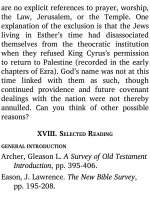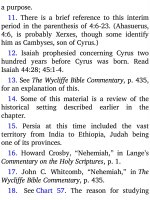Jensens survey of the old testament adam 68
Bạn đang xem bản rút gọn của tài liệu. Xem và tải ngay bản đầy đủ của tài liệu tại đây (195.2 KB, 4 trang )
(chap. 16)
The Day of Atonement was the most
important day of Israel’s calendar, for it was
then that the idea of atonement for sin
reached its highest expression. Sin and burnt
o erings were part of the day’s ritual. Only
on this day could the high priest enter into
the most holy place of the tabernacle. This
was the only day of the year for which
fasting was required, in bold contrast to the
atmosphere of rejoicing that attended the
annual feasts. On no other day were the
Israelites more strongly impressed with the
grace of God in forgiving all their sins. The
gospel of this day was a bright prophetic
sign of the coming Gospel of the event of
Calvary, when Jesus would sacri ce Himself
for the sins of man, once for all. Oswald T.
Allis sees the Day of Atonement as the peak
of Leviticus.
E. DAY OF ATONEMENT
To understand Calvary, and to see it in
its tragic glory, we must view it with
all the light of sacred story centred
upon it. With Isaiah, the “evangelical”
prophet of the old dispensation, and
with the writer of the Epistle to the
Hebrews, we must turn to Leviticus
and read of the great day of
atonement, and of the explanation
which is given of it there: “For the life
of the esh is in the blood: and I have
given it to you upon the altar to make
an atonement for your souls: for it is
the blood that maketh an atonement
for the soul” (Lv xvii. ii).8
(chaps. 23-25)
God instituted holy times (cf. holi-days) in
the calendar of the Israelites so that His
people would set aside many days of the
year to meditate on who He was and what
He had done for them. The convocations
F. HOLY TIMES
had a wholesome, positive purpose about
them, to emphasize that believers were to be
separated unto the Lord, as well as separated
from evil. And what the Israelites learned
and experienced at these holy seasons, they
were to practice daily, step by step,
throughout their life.
Chart 19 lists the holidays described in
Leviticus 23-25. As you read the Bible text,
look for the main purpose of each
convocation, and observe the prominent
truths revealed by each about God.
Charts 20a and 20b show how the feasts
are distributed in the Hebrew calendar.9
V. KEY WORDS AND VERSES
Some of the most prominent key words
and phrases of Leviticus are “holy” (about
ninety times), “blood,” “life,” and “before
the LORD” (about sixty times).
Key verses suggested for Leviticus are









